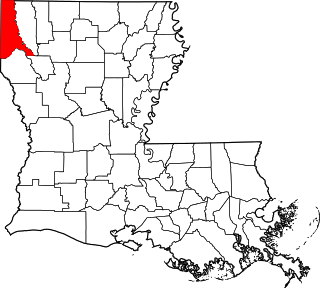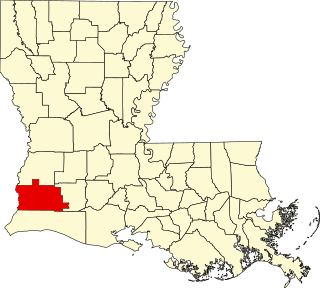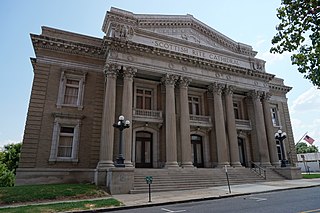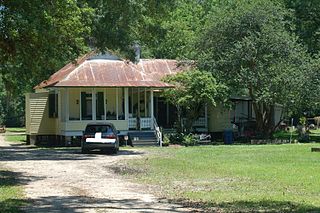
Albany is a town in eastern Livingston Parish, Louisiana, United States. The population was 1,088 at the 2010 census and 1,235 in 2020. It is part of the Baton Rouge metropolitan statistical area.

The original campus of Centenary College of Louisiana is located along College Street in Jackson, Louisiana. It is operated and preserved as a museum by the Louisiana Office of State Parks as the Centenary State Historic Site, offering educational interpretive programs and guided tours.

The Old Louisiana State Capitol, also known as the State House, is a historic government building, and now a museum, at 100 North Boulevard in Baton Rouge, Louisiana, U.S. It housed the Louisiana State Legislature from the mid-19th century until the current capitol tower building was constructed from 1929-32.

Baton Rouge station is a historic train station located at 100 South River Road in downtown Baton Rouge, Louisiana. It was built for the Yazoo and Mississippi Valley Railroad which got absorbed by the Illinois Central Railroad. The station was a stop on the Y&MV main line between Memphis, Tennessee and New Orleans, Louisiana. The building now houses the Louisiana Art and Science Museum.

The Old Louisiana Governor's Mansion is located at 502 North Blvd. between Royal and St. Charles Streets in Baton Rouge and was used as Louisiana's official gubernatorial residence between 1930 and 1963; a new residence was completed in 1963. The Old Governor's Mansion was built under the governorship of Huey Long, its first resident. The building is reported to be inspired by the White House in Washington D.C. as it was originally designed by Thomas Jefferson. It is said that Long wanted to be familiar with the White House when he became president, so he had the White House duplicated in Baton Rouge. Some dispute this legend and simply say that the building is merely a fine example of a Georgian-style mansion.

Marksville Prehistoric Indian Site, also known as the Marksville site, is a Marksville culture archaeological site located 1 mile (1.6 km) southeast of Marksville in Avoyelles Parish, Louisiana. The site features numerous earthworks built by the prehistoric indigenous peoples of southeastern North America.

This is a list of the National Register of Historic Places listings in Caddo Parish, Louisiana.

This is a list of the National Register of Historic Places listings in East Baton Rouge Parish, Louisiana.

This is a list of the National Register of Historic Places listings in DeSoto Parish, Louisiana.

This is a list of the National Register of Historic Places listings in Calcasieu Parish, Louisiana.

This is a list of the National Register of Historic Places listings in Jefferson Parish, Louisiana.

The Scottish Rite Cathedral is a historic building located at 725 Cotton Street in Shreveport, Louisiana. It was designed in 1915 by architect Edward F. Neild in Beaux Arts style.

The History of Louisiana Tech University began when the Industrial Institute and College of Louisiana was founded in Ruston, Louisiana in 1894. The institute was founded to develop an industrial economy in the state of Louisiana. Four years later, the school was renamed the Louisiana Industrial Institute when Louisiana adopted the Constitution of 1898. When the Constitution of 1921 was passed, the school changed its name again to Louisiana Polytechnic Institute to reflect the school's evolution from a trade school into a larger and broader technical institute. Although the university was informally called Louisiana Tech for about five decades after the 1921 name change, it was not until 1970 when Louisiana Polytechnic Institute officially changed its name to Louisiana Tech University. Over the course of its history, the school grew from a small industrial institute with one building to a university with five colleges and an enrollment of around 11,800 students.

St. Elizabeth of Hungary Catholic Church is a historic Roman Catholic church is located at 114 Louisiana Highway 403 in Paincourtville, Louisiana, in Assumption Parish. In 2000 the ecclesiastical parish of St. Elizabeth was clustered with St. Jules in Bell Rose, also in the Diocese of Baton Rouge.

The Dixie Center for the Arts, also known as the Dixie Theater or simply the Dixie, is a theater-style venue located at 212 North Vienna Street in Ruston, Louisiana.

The Decareaux House, also known as the Creole House Museum, is a historic house located at 16061 Louisiana Highway 16 in French Settlement, Louisiana, United States.

The Deslattes House is a historic house located at 15620 Louisiana Highway 16 in French Settlement, Louisiana, United States.
The Guitreau House, also known as Belle Place, is a historic house located at 16825 Louisiana Highway 16 in French Settlement, Louisiana, United States.

The Adam Lobell House is a historic house located at 15715 Louisiana Highway 16 in French Settlement, Louisiana, United States.
























